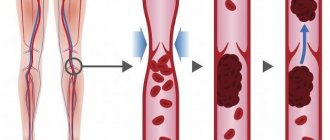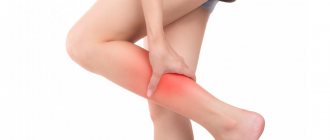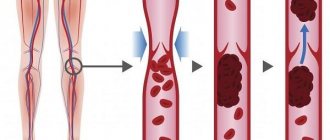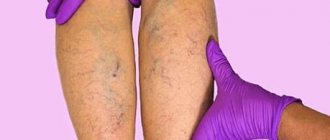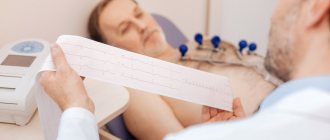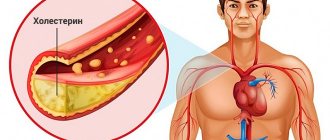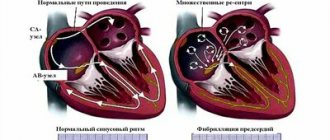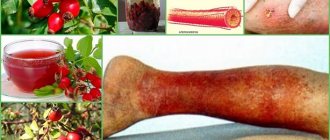Thrombophlebitis (TF) is an inflammatory process that affects the wall of venous vessels, resulting in the formation of blood clots. Depending on the stage of development, several types of the disease are distinguished.
Signs of the development of pathology are an increase in body temperature, redness and thickening in the area of the affected vein, pain, etc. These symptoms should be the reason for mandatory contact with a specialist who will conduct an examination and identify the cause of these symptoms.
Medical offers its clients high-quality and professional assistance from a phlebologist in the diagnosis, treatment and prevention of vein diseases, including varicose veins. In the clinic, equipped with modern equipment and equipment, you can receive high-quality services from experienced doctors at reasonable prices.
What is venous thrombophlebitis?
The disease is an inflammatory process that takes place in the venous wall, and is accompanied by the formation of blood clots (thrombi), which have different densities and close the lumen of the vein. As a result, partial or complete blockage of blood vessels occurs.
The pathology has an acute and chronic form, and can occur in superficial and deep veins. TF is most often diagnosed in the lower extremities, but it can also affect the venous vessels of any other parts of the body. If therapy is not carried out correctly and on time, it can cause undesirable consequences, including:
- purulent abscess;
- blood clot separation;
- blood poisoning.
Thrombophlebitis of the superficial veins has more severe symptoms compared to the disease affecting the deep veins. However, in both cases, timely diagnosis is very important, which will allow you to begin treatment without wasting time, and thereby avoid worsening the situation.
Types of thrombophlebitis of the lower extremities
Depending on the affected area, the following types of thrombophlebitis of the lower extremities are distinguished:
- TF of the superficial veins begins with the appearance of mild pain in the skin located along the saphenous veins. The skin changes its hue to red and becomes inflamed, its temperature rises. Also, in some cases, there is a slight increase in the temperature of the whole body, which remains elevated for about 6 days. Symptoms of this type of pathology include swelling of the limb in which a blood clot has formed. Condensed areas of various sizes may appear on it, which can be easily palpated. Painful sensations appear while walking.
- Deep vein TF, manifestations of which occur only when the blood clot enlarges. If a blood clot breaks off, chest pain, shortness of breath, and expectoration of blood occur. The development of pathology is indicated by swelling, pain during movement, and a change in the shade of the skin to bluish.
The severity of the disease is determined by the size of the filling and its location in the body. Symptoms are completely absent if there is no blockage of the vessel. This makes it much more difficult to identify the problem in a timely manner.
Septic thrombophlebitis of veins is also distinguished. It occurs due to purulent melting of a blood clot and transmission of infection through the bloodstream.
Based on characteristics such as the location of the affected area, TFs are distinguished:
- upper and lower extremities;
- vessels of internal organs.
Causes of deep vein thrombosis
Blood clots are made up of clumps of blood cells called platelets, which every person has for survival. Platelets are responsible for allowing blood to clot in an injured artery or vein to stop bleeding when you are hurt, scratched or bruised.
Platelets stop excessive bleeding and help repair damaged blood cells, along with a network of other red blood cells and a type of protein called fibrin. However, this process can also sometimes lead to the formation of blood clots, sometimes causing symptoms and serious complications.
Not everyone who has a blood clot experiences any noticeable symptoms. However, the clot itself usually causes inflammation, swelling and local problems at the site of its formation.
Reasons for education
Blood clots stick together much faster in the area where the pathological lesion occurred. This provokes a more rapid narrowing of the lumen and disruption of tissue nutrition. Key factors contributing to the development of the disease include:
- excess weight;
- lower limb injuries;
- varicose veins;
- incorrectly administered injection;
- the presence of tumors in the digestive system;
- low level of physical activity;
- previous operations;
- pregnancy;
- prolonged stay in an uncomfortable position;
- alcohol abuse and smoking;
- hormonal treatment and contraception;
- autoimmune processes.
Women are at higher risk of developing the disease due to high estrogen levels. It has also been proven that COVID-19 in 70% of cases causes an overreaction of the immune system, which causes a large number of blood clots to form.
Symptoms and signs of thrombophlebitis
Symptomatic signs of TF vary depending on the form of its course. In the case of acute pathology, its symptoms appear within the first two weeks. The subacute form is characterized by the manifestation of symptoms within a month.
If we are talking about TF of the superficial veins, then its signs are painful sensations when palpated, redness of the skin in the affected area, and the appearance of a clear venous pattern. TF of the deep veins is characterized by swelling. Symptoms also include:
- difference in temperature between healthy and affected areas;
- pain that increases with exercise;
- tissue tension;
- chills, etc.
Among the symptoms of the disease, there are also those that can only be detected during medical diagnosis. This:
- decreased blood circulation rate;
- thickening of vascular walls;
- occlusion;
- valve dysfunction;
- increased blood viscosity.
Thrombophlebitis, the symptoms of which are described above, requires urgent medical intervention if the swelling and pain are pronounced, and there is also fever or shortness of breath, accompanied by coughing attacks and spasms in the chest. These symptoms indicate an increased risk of blood clots breaking off and subsequently entering the lungs, which will lead to death.
Home Recipes for Treating Thrombosis
There are proven folk remedies for the treatment of thrombophlebitis. The most common method is compresses:
- With honey. Apply slightly heated natural honey to a gauze bandage, wrap the leg in the problem area, secure the compress with a thick cloth, and leave for 2-3 hours. Do this for 3 days, after which increase the time of application of the compress to 6-8 hours a day.
- With wormwood. You need to crush a bunch of fresh flowers in a mortar and mix with thick sour milk. The proportion is approximately half. The mass should turn out mushy. Apply a tablespoon of the product to gauze, apply to the affected area, secure and leave for 1.5-2 hours. Repeat the procedure daily for 3-4 weeks.
- With Kalanchoe leaves and vodka. Grind 100g of the plant, pour in 500ml of vodka, pour the solution into a closed container and place in a dark place for a week. The liquid should be shaken once a day. Then strain the product and rub it on your legs every day from the foot to the thigh. The course of treatment is 1 month.
- With cabbage. Take a large leaf of white cabbage and apply vegetable oil to the side that you will apply to your leg. Fix the sheet to the affected area with gauze or soft cloth and leave for 6-7 hours. Repeat the procedure daily for a month.
- With tomatoes. Grind red tomatoes to a pulp, apply to gauze and apply to the problem area. Secure the compress with a cloth and leave for 2-3 hours. Repeat the procedure twice a day for 2 weeks.
Treatment of thrombophlebitis with folk remedies is also possible using solutions for internal use:
- With hops. Pour 1 tablespoon of pine cones with a glass of boiling water and heat in a water bath for 15 minutes. You need to take the solution twice a day, half a glass - after waking up and before going to bed.
- With the root of the field steelweed. 30g of crushed roots need to be poured into 400ml of water and boiled for 15 minutes. Then you need to let the solution brew for half an hour and strain. Take half a glass three times a day before meals.
- With nettles. 3 tablespoons of crushed leaves need to be poured into 500 ml of water, boiled, allowed to brew and strain. Take 100 ml three times a day an hour after meals.
Diagnostics
To diagnose the disease, you should contact a qualified specialist. He will conduct an examination and prescribe additional measures to study the patient’s condition, including:
- Ultrasound;
- phleboscintigraphy;
- angiography;
- phlebography.
Any experienced phlebologist will suspect TF already during a visual examination, during which he will detect dense and painful nodes located under the skin of a red tint. However, to accurately confirm the diagnosis, an ultrasound examination of the veins in the legs should be performed. This method will allow the doctor to examine thrombotic masses in the lumen of the vein and assess the degree and nature of thrombosis.
After examining the patient, the phlebologist receives data that will help him prescribe appropriate therapy. Yuzhny MC specialists conduct research using modern equipment from trusted manufacturers, which, combined with their qualifications, allows them to accurately identify the disease and begin its treatment.
Which doctor should I contact?
If there are clear signs of the development of TF or other vascular diseases (varicose veins, gangrene, thrombosis, tropical ulcers, etc.), you should consult a phlebologist. His competence includes examining the patient in order to make a diagnosis and subsequently prescribe treatment. You can also contact a specialist in this profile to receive clarification on preventive measures.
You can make an appointment with a phlebologist at a medical clinic, where experienced specialists work who have confirmed their qualifications with many years of successful experience in identifying and eliminating diseases of the venous system. The clinic is equipped with the latest technology, which allows diagnosis and treatment to be made even more efficiently and quickly.
Diagnostic methods
During the initial consultation, the doctor conducts a visual examination of the affected limb and collects an anamnesis, however, many important data necessary for diagnosing thrombophlebitis can only be determined with the help of instrumental studies:
- Ultrasound of superficial vessels to determine the extent and location of blood clots;
- Doppler ultrasound to identify the characteristics of blood flow in the vessels of the limb;
- rheovasography, which helps to identify disturbances in the blood supply to tissues and organs;
- Ultrasound duplex scanning of veins is the most informative study that allows you to determine all important diagnostic indicators - the speed and direction of blood flow, the condition of the venous wall, the level of preservation of the vein lumen, etc.
In addition, the doctor prescribes general laboratory tests to clarify the patient’s general health, and a coagulogram to determine blood clotting indicators and the tendency to form blood clots. Additional studies may be prescribed according to indications.
Treatment of thrombophlebitis
The treatment regimen for thrombophlebitis is determined by the doctor based on the results of the patient’s examination and the stage of development of the disease. Today, both conservative treatment and surgical intervention are used to combat pathology. Only the attending physician has the authority to prescribe a particular therapeutic method.
At the present stage of development of medicine, pathology therapy does not necessarily involve a complex surgical operation. In some cases, it is possible to treat a person on an outpatient basis by taking medications prescribed by a phlebologist. At the same time, it is important to avoid any amateur activity in prescribing drugs in order to avoid aggravation of symptoms.
Some patients may be advised to wear compression stockings and elastic bandages if their general condition allows it. Drug treatment sometimes includes anticoagulants and anti-inflammatory drugs.
Operation
Surgery for TF is indicated in the following cases:
- the presence of signs of disease in the proximal part of the veins;
- combination of pathology with damage to the superficial vascular network;
- localization of the disease in the distal part of the vessels (does not require urgent surgical intervention, a planned operation is performed);
- thrombophlebitis of the deep veins of the lower extremities. In this case, the operation is prescribed taking into account the characteristics of the individual’s body.
In modern surgical practice, several types of operations are used to eliminate TF. Despite their differences, each type guarantees a good result. Popular techniques include:
- Crossectomy. During this type of operation, pathological areas of blood vessels are crossed in the area of the saphenofemoral junction.
- Stitching of the vena cava of the lower limb, which is carried out to narrow its lumen. This will not interfere with normal blood circulation, but will prevent it from carrying a large clot.
- Installation of a vena cava filter in the vein that supplies the leg. It is a design whose purpose is to retain large blood clots in order to prevent them from entering the general bloodstream.
- Endovascular method of catheter thrombectomy. It is carried out to completely remove clots from the lumen of deep veins and regenerate their patency. This leads to improved blood circulation and a reduced risk of progression of pulmonary embolism.
Laser treatment
The disease has been successfully treated for many years using laser. This technique, which allows you to relieve inflammation, pain and swelling, is carried out a day or two after the exacerbation subsides and is one of the most common today.
Laser treatment of the disease involves inserting a special device into a vein. It produces a temperature effect that leads to sealing of the damaged vein and stops the process of formation of blood clots in it. The main advantage of the manipulation is that it can be performed on an outpatient basis and there is no need to make surgical incisions on the skin.
Conservative
Conservative therapy for TF can only alleviate the symptoms of the disease. However, it is not effective in completely eliminating the threat of dangerous complications due to its inability to radically solve the problem.
This treatment includes:
- Consumption of non-steroidal medications that have an anti-inflammatory effect and relieve pain.
- Mandatory elastic compression. It is recommended to choose stockings over bandages.
- Local therapy, which includes ointments and creams containing non-steroidal anti-inflammatory components.
- Anticoagulant treatment involves taking medications that thin the blood and reduce inflammation.
Physiotherapy
Thrombophlebitis, after the removal of the acute inflammatory process, is also subject to treatment with physiotherapeutic techniques. Physiotherapy as a method of combating thrombophlebitis is prescribed for the purpose of:
- suppression of blood clotting;
- slowing down the development of the process of sclerosis of veins;
- eliminate inflammation;
- hemodynamic regeneration;
- reducing pain.
The main physiotherapeutic techniques include:
- UHF treatment;
- infrared laser therapy;
- CHUV irradiation with erythemal doses;
- high-frequency magnetic therapy;
- electrophoresis with the use of medications that have an anti-inflammatory effect;
- applications of paraffin and ozokerite.
Contraindications to physiotherapy in the treatment of acute thrombophlebitis are:
- The patient's body temperature rises above 38 degrees.
- Purulent processes in the body.
- Ischemic thrombophlebitis.
In order to exclude the possibility of developing thromboembolism, it is prohibited to use TF in therapy:
- Magnetotherapy with a “running” magnetic field.
- Vibration therapy.
- Low frequency electrotherapy.
- Pulsed magnetic therapy.
Vaccinations
People with acute TF should refrain from vaccination against coronavirus infection. If at the time of vaccination a person does not have an exacerbation of the chronic form of the disease, then there is no need to fear the formation of blood clots under the influence of vaccination.
It is worth considering that infection with COVID-19 increases the risk of blood clots and an extremely undesirable outcome. In this regard, patients suffering from TF are recommended to undergo vaccination against coronavirus.
Today, there are rare cases of complications occurring after vaccination in the form of blood clots. However, both domestic and foreign recommendations for the use of vaccines do not include a tendency to blood clots among the contraindications. Therefore, it is appropriate to say that the risks of contracting COVID-19 are much higher than the rare complications that arise during the post-vaccination period.
Traditional methods
Treatment of the disease with folk remedies should be auxiliary in nature and used only with the approval of the attending physician. It can give positive results only at the initial stage of development of the pathology, but it is not effective in its advanced form. Folk remedies are indicated to prevent the development and possible complications of TF.
Discussion of traditional methods of treatment with a doctor is mandatory if a person does not want to worsen the situation. The fact is that some alternative medicine recipes include plants that stimulate the functioning of the adrenal glands and are contraindicated in patients suffering from hypertension.
Traditional Treatment for Deep Vein Thrombosis Symptoms
The traditional approach to treating deep vein thrombosis includes:
Related articles:
- Vitiligo: treatment with folk remedies
- Rutin: indications for use, how much to take per day
- Prescribing blood thinners (such as anticoagulants, heparin, or warfarin) and breaking up clots with drugs such as Coumadin.
- Thrombolytic drugs are used to dissolve clots and prevent them from moving where they can contribute to pulmonary embolism.
- For people who cannot take blood thinners, a vena cava filter is sometimes used to catch the clot before it reaches the lungs or brain.
- Most doctors also usually recommend lifestyle changes, including quitting smoking and starting to exercise.
Treatment depends on the individual case as well as personal medical history. Unfortunately, under the orders of many doctors, many people (especially those who have had vascular problems or injuries that make them less active) remain on medications that are used to treat thrombosis throughout their lives.
Blood thinner medications can cause many different side effects, including bleeding complications that can sometimes be serious and even life-threatening. Given these adverse effects, it is important to weigh the pros and cons of taking any blood thinning medications and do your best to treat deep vein thrombosis with home remedies.
If you are using medications to treat thrombosis, talk with your doctor about limiting your use to one or two months or less using the lowest dose. Also try not to take other drugs at the same time as blood thinners that can cause negative side effects, including aspirin or ibuprofen. Also, many naturopathic medications and supplements should not be taken with blood thinners. Consult a naturopath before use.
Who is at risk?
The risk group for developing the disease includes the following categories:
- Pregnant women, women after childbirth and on hormone replacement therapy.
- Patients with a malignant tumor.
- Women who have been using contraceptives for a long time.
- Patients with excessively limited physical activity.
- Patients with pathologies of the venous system.
The likelihood of developing the disease is also high for people:
- Over the age of 60.
- With a previous stroke and episodes of TF.
- Smoking abusers.
- Suffering from obesity.
It is worth remembering that regular physical activity and giving up bad habits stimulate normal blood circulation, which will avoid the formation of blood clots. People who are included in one of the above risk groups should contact a phlebologist for an examination and recommendations for preventive measures.
Complications of thrombophlebitis
Thrombophlebitis, the treatment of which is ignored or carried out incorrectly, can cause a number of complications. If we are talking about pathological damage to the superficial veins, then serious complications are rare. But they cannot be ignored because of the damage they can cause to health:
- Sepsis.
- Streptococcal lymphangitis.
- Spread of infection in the subcutaneous tissue.
- Change in skin color over the affected vessel.
- Thromboemolia of the pulmonary artery.
- Deep vein thrombosis.
The situation is more serious with the development of deep vein disease. In this case, the following complications are possible:
- Stroke or heart attack for patients with congenital heart disease.
- Pulmonary embolism. Part of the blood clot that breaks off in a deep vein is carried by the bloodstream to the lungs. It can block arteries and cause a situation that is extremely life-threatening.
- Blockage of veins by blood clots, resulting in a complete blockage of blood flow in the vein.
Signs and symptoms of deep vein thrombosis
Although thrombosis does not always cause symptoms, some people experience the following: ()
- Skin redness, warmth, and swelling around the affected area (including the leg or pelvis). Sometimes the skin appears discolored and red or dark spots appear.
- Pain near the site of the clot. It may develop in just one leg or both.
- Difficulty walking or moving.
- Sometimes scales or ulcers form on the affected part of the body.
Symptoms of a blood clot in the leg may indicate where the clot is forming, although not always. According to scientists, blood clots in the thighs are more likely to rupture and cause complications than blood clots in the lower legs or other parts of the body (). If you suspect there is a clot in one of your thighs, tell your doctor right away and watch closely for other symptoms.
Diet
People suffering from TF or at risk of developing this disease should eat as little as possible foods containing vitamin K, which stimulates blood clotting. These products include:
- Bananas;
- Cabbage;
- Pork liver;
- Black currant;
- Soy;
- Beans, etc.
You should also be careful about foods that are involved in the formation of blood clots:
- Confectionery and baked goods.
- Fat meat.
- Canned food.
- Sausages.
- Walnuts.
It is recommended to limit the consumption of salt, sugar, sour cream and butter, and include more plant foods in the diet, including herbs, fresh fruits and vegetables, and grains. Consumption of lean meat and seafood is allowed.
People suffering from TF should eat beef liver, which strengthens the walls of blood vessels, as well as buckwheat, melon, oatmeal, cinnamon, ginger, onions, citrus fruits, dairy products, etc. It is best to steam, or boil or stew foods. Fried, salted and smoked foods are excluded. The daily volume of fluid consumed should not be less than 2.5 liters, not counting strong tea, carbonated drinks and coffee.
Prevention of thrombophlebitis
If you have questions about how to treat thrombophlebitis and what measures to prevent it, you should contact a competent phlebologist. He will give precise recommendations regarding activities that will reduce the likelihood of developing the disease. People with two or more risk factors should definitely see a specialist. Prevention, carried out in time, will help eliminate the inflammatory process and the formation of blood clots in the veins. Prevention of the disease is also carried out to prevent its complications. Preventive measures include:
- Massage.
- Healthy lifestyle.
- Proper nutrition.
- Choosing the right clothes and shoes.
- Taking care of hygiene.
- Constant physical activity.
- Timely elimination of colds and infections.
Walking, swimming, cycling and dancing will have a positive effect on your health. Hardening procedures will help strengthen the walls of blood vessels.
Deep vein thrombosis - treatment with folk remedies
Next, we'll look at a naturopathic approach to preventing and treating deep vein thrombosis. Used only in non-acute conditions.
Exercise and move more
If you lead a sedentary lifestyle, including sitting for long periods of time at a desk or other place, especially cross-legged, you are much more likely to develop thrombosis. The best type of exercise to keep your heart and veins healthy is one that combines aerobic exercise (such as running, cycling) with strength training and stretching for flexibility. Incorporate knee and leg strengthening exercises such as squats, walking and lunges if you have a history of thrombosis.
Before you start, if you have recently been diagnosed with a blood clot, be sure to consult with your doctor and let him know that you are ready to exercise. In addition to exercising, take breaks from sitting and be sure to stretch. For example, if you're going on a long car or plane trip, be sure to get up at least every hour (ideally more often if you're at work, such as every 20 minutes) to take a break.
Incorporate more exercise into your day, with short breaks in your regular routine so you can walk, move, or stretch your legs to maintain blood flow. If you are recovering from surgery or injury, get up and move as soon as it is safe to do so.
Pay attention to the medications you take
Certain medications and disorders increase the risk of blood clots and may contribute to the development of deep vein thrombosis. These include hormone medications (commonly used by menopausal or postmenopausal women), birth control pills, medications to control blood pressure, and medications to treat cancer.
It is recommended that you consult your doctor regularly to see if the amount of medications you take can be reduced or if they may be contributing to any problems. If you decide to take blood thinners, be sure to take them strictly under your doctor's supervision and make sure your dose is not too high or used for too long.
Eat a healthy diet
Treatment with folk remedies for deep vein thrombosis is based on proper nutrition. Maintaining a healthy diet as you get older is critical to managing your weight, controlling your blood pressure and maintaining a healthy cardiovascular system. Foods high in vitamin K, potassium and magnesium are especially beneficial for regulating blood flow. Green leafy vegetables, cruciferous vegetables, avocados, sweet potatoes and bananas contain high amounts of these nutrients. However, keep in mind that vitamin K may interact with blood thinners, so make changes to your diet only under the supervision of a doctor.
Stay hydrated and reduce your intake of sugar, caffeine and alcohol. It is also helpful to include some herbs and supplements in your treatment or prevention plan to promote healing and heart health. Foods, herbs and supplements that may have natural anticoagulant and anti-inflammatory properties include: ()
- Vitamin E and Vitamin D Foods: Found in fruits, vegetables, cage-free eggs and some types of mushrooms.
- Spices and herbs including garlic, turmeric, oregano, cayenne pepper and ginger.
- Real dark cocoa/chocolate
- Evening primrose oil
- Fruits such as papaya, berries and pineapple
- Raw honey
- Vinegar
- Green tea
- Fish oil and omega-3 fatty acids
Take Supplements
Next, we will look at two recommended supplements that are used in naturopathic protocols for correcting deep vein thrombosis. The links are clickable, the drugs can be purchased in the iherb.com store.
Pycnogenol (maritime pine extract)
French maritime pine bark extract has been demonstrated to reduce platelet aggregation while increasing the activity of a blood flow enhancing enzyme that generates nitric oxide in blood vessels. Nitric oxide plays a critical role in regulating vascular function, which reduces the risk of blood clots (, ).
Country Life, Pycnogenol, 100 mg, 30 Vegetarian Capsules
Nattokinase
Research has shown that natokinase breaks down fibrin—the long, thread-like molecules that make up the main protein found in blood clots—and its precursor, fibrinogen, both of which are involved in the formation of red blood cells. Nattokinase reduced levels of other factors in the blood clotting cascade while increasing levels of factors that prevent blood clotting. Specifically, nattokinase reduces the activity of two proteins (factor VIII and factor VII) that can cause unwanted clotting when elevated ().
Doctor's Best, Nattokinase, 2000 FU, 90 Vegetable Capsules
Given these observations, scientists have recognized that these two extracts may lead to significant prevention of deep vein thrombosis by:
- inhibiting the formation of unwanted blood clots in the veins,
- improving microcirculation in the veins of the legs,
- increasing the elasticity of the walls of blood vessels,
- inducing the breakdown of fibrin clots.
Do not smoke
No home remedy treatment for deep vein thrombosis will work if you smoke.
Smoking cigarettes or using e-cigarettes and other tobacco products are all serious risk factors for thrombosis, especially when combined with other risk factors such as being overweight (). Breaking this bad habit is critical in your thrombosis treatment program.
Use compression stockings
Wearing compression stockings can help reduce pressure, swelling and pain in the affected area where the blood clot has formed. Keeping the affected area elevated and applying moist heat where it hurts can also help you heal. Compression is also used because lower blood pressure reduces the chances of developing another clot in the future, and it can help you recover faster and get back to an active life.
Compression stockings can be purchased online or in special orthopedic stores. You can remove the stocking while working out or showering and use it along with other natural pain relief remedies such as essential oils, stretching, and massage.
What can be done for thrombophlebitis?
For patients with thrombophlebitis of the legs, regular moderate physical activity is recommended, as well as wearing compression stockings during the day on an ongoing basis. Daily walking in comfortable shoes will also help improve the condition of a person suffering from TF. Physical activity is allowed, but the degree of its intensity must be determined together with the attending physician based on the stage of development and type of pathology, as well as the individual characteristics of the patient’s body.
What is prohibited for thrombophlebitis?
If a person develops a disease, he is strictly prohibited from:
- Wear uncomfortable high-heeled shoes.
- Lift heavy objects.
- Engage in sports that involve intense stress on the limbs.
TF of deep veins is a restriction for visiting saunas, drinking bowls and baths. This is due to the fact that high temperatures significantly accelerate blood circulation, which has an extremely negative effect on the course of the disease.
It is strictly forbidden to gain extra pounds, and therefore a person must pay special attention to proper nutrition. Animal fats, which can be replaced with vegetable oils, should be excluded from the diet. The amount of salt consumed should be kept to a minimum in order to eliminate swelling. Quitting alcohol and smoking is mandatory for TF.
The difference between thrombophlebitis and varicose veins
TF and varicose veins have similar symptoms. However, their nature is different. In the case of varicose veins, the vessels are dilated and their walls are thinned. The result is impaired blood flow and the formation of nodes. In the case of thrombophlebitis, inflammation of the venous walls and thrombus formation occurs. The thrombus clogs the lumen of the vessel, which leads to disruption of blood flow and swelling of the affected vessel.
The key difference between the diseases lies in the pathological mechanisms underlying each of them. Disruption of the functions of the valvular venous apparatus and excessive expansion of their lumen occurs as a consequence of destructive changes in the vessels formed under the influence of harmful factors. But the pathology occurs only with impaired blood circulation in the venous line and trophism of the soft tissues located around the affected vessel. A complication of varicose veins that cannot be treated is thrombophlebitis.
Common methods of treating the disease
Treatment measures in case of thrombophlebitis can be:
- Conservative. The patient is prescribed medications for topical use that help resolve blood clots, as well as medications for oral administration that thin the blood.
- Surgical. When the problem becomes rampant, doctors are forced to use radical methods to save the patient’s life. The operation involves complete removal of the vein or excision of thrombosed nodes. If a floating thrombus is detected in a patient during diagnosis, installation of a vena cava filter is indicated.
